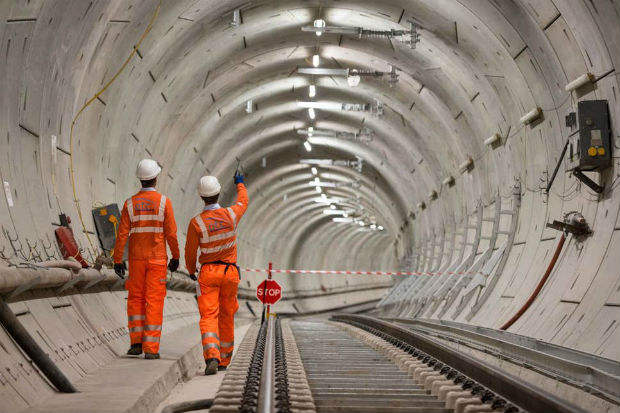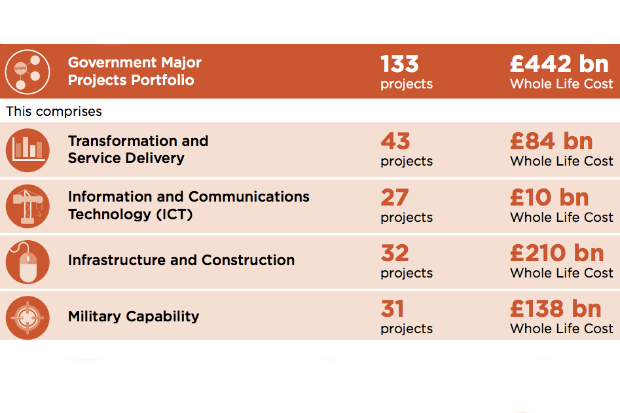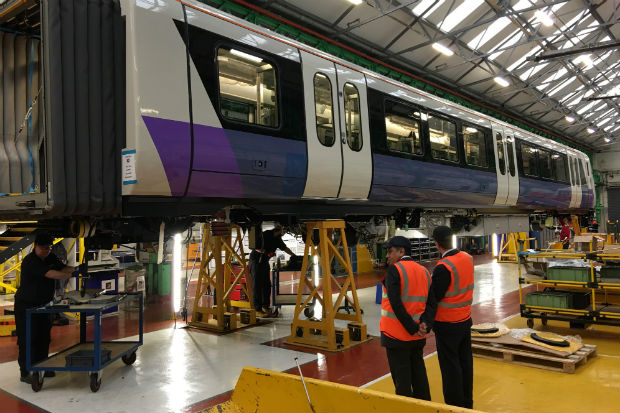
The vast ambition and scale of projects and programmes being developed and delivered right across government is truly impressive. They range from transforming vital public services, to building our infrastructure across the country, to delivering EU Exit, with project delivery professionals working daily on implementing government’s top priorities.
It is probable that over the next few years the Government Major Projects Portfolio (GMPP) will grow in size, with upcoming priorities such as (carbon) NetZero 2050, a new Spending Review reflecting government priorities and EU Exit.
We are doing a lot and we are ambitious with these projects, often delivering groundbreaking technologies. At the same time we are aware of the challenges facing us on some of the biggest projects, so this is an opportune moment to pause. We must develop strategies to address these challenges and to be ever more successful in delivering better outcomes.
To improve delivery, with plans that are stretching but also realistic, we need to make sure we learn lessons from projects that have gone before and that we apply those lessons to future projects.
From our position at the centre of government, the IPA has been working closely with some of the biggest and most timely portfolios, doing exactly this.

Cross-government transformation portfolio
The sheer scope, scale and complexity of this portfolio is extraordinary. All these projects are designed to transform services for citizens, improving government efficiency and implementing new policy.
While the portfolio spend may be less than that on infrastructure, the benefits of transformation can be huge, and delivering these projects incredibly challenging. By their very nature, complex transformations usually involve significant organisational and cultural change, introducing new ways of working and experimenting with new and innovative technology.
The IPA has been working with the wider centre on this type of programme, specifically to support departments in maximising the delivery of these benefits.
One important lesson we have learned is that programmes do not always give sufficient thought to the effort and time required for changing behaviours. The IPA has been supporting programmes to improve the likelihood of successful delivery by encouraging a real focus on people and behaviour change from the outset.
It is also important to highlight that transformation programmes are often iterative in nature. They provide value throughout their lifecycle and typically last longer than a single Spending Review period.
This means the IPA encourages programmes to consider how they can deliver benefits throughout the duration of the project, rather than in a single ‘Big Bang’ event. Embedding this principle gives space for programmes to iterate and learn from their own lessons and to improve each stage of delivery.
We need to grow our capability in programme delivery and recognise the differences between delivery of a single entity and the complexity of programme and portfolio management.
7 Lenses of Maturity
The IPA and GDS supported the Home Office to create the 7 Lenses of Maturity Matrix. This is a practical tool to help teams reflect on their transformation, focus discussions and identify which areas need more attention.
The Defence Learning and Management Capability Programme at the Ministry of Defence (MOD) is one such team. Using the matrix, the programme found that by having representatives from each of the armed forces in the room, alongside the transformation team and other key corporate groups, they were able to hold more focused discussions. By applying the 7 Lenses and understanding their maturity against it, MOD was able to identify the areas that needed the most attention and highlight those where they could learn lessons.
Infrastructure and construction portfolio

In the infrastructure space, there is no doubt that the construction industry is in a fairly febrile state, with the demise of Carillion casting a long shadow over the market’s ability to deliver.
Learning Legacy websites have been set up for a number of government’s major infrastructure projects, including London 2012, Crossrail and the Thameslink programme. For example, a review of the delivery model used on Crossrail identified a number of lessons learned or recommendations for future major infrastructure projects, including that:
- adequate time be provided to think through a detailed execution strategy before a robust plan or programme is developed
- client objectives must be clearly cascaded down the entire supply chain to align effort
- the use of effective competition in the supply chain will result in improvements in overall performance
- planning for the testing, commissioning and handover of complex projects should be accomplished as early as possible
While these lessons cannot be applied universally, there were shared features that it is important to learn from and apply.
But you cannot simply flick a switch and fix some of these issues. It will require a change in behaviour and culture from all parties, both public and private.
This resonates with some recent analysis we have undertaken with the Department for Transport on learning lessons from major projects. I would highlight three of the lessons we have learned:
- Behaviours and culture are just as important as process. You can have a perfectly designed governance structure, but the management of a project comes down to the people working in it.
- We need to ‘get real’ with optimism bias, paying closer attention when things are going well. It’s easy to forget to apply the same care and attention to detail as we do when we worry about a project.
- We need to put greater focus on systems integration, as complex technology is playing an increasing role in our big infrastructure projects. To be frank, the industry needs to develop the right skills, as it’s an industry that’s been associated with just diggers and concrete for too long. Productivity can and must improve.
Picking out these lessons is the easy part. Applying them in practice is more difficult. If we are to deliver the next generation of infrastructure projects well, and sustain our £600 billion National Infrastructure and Construction Pipeline of investment, we need to get this right.
We are clear that there’s no silver bullet for delivering major infrastructure projects to time and budget. Much of what we want to achieve is about driving a culture change across government and the industry over the long term, sticking to clear principles that align with successful outcomes.
EU Exit
Despite our successes and improvements we now need to apply our focus – we still have a way to go. The IPA is committed to continually improving project delivery in government and, in the last year alone, just under a third of all GMPP projects have improved their delivery confidence.
We are already starting to see positive changes to our ways of working, particularly with the delivery of EU Exit. There is no doubt that from a delivery point of view, the legacy will be profound.
IPA support and assurance for EU Exit has focused on the most critical programmes. We have, as always, looked at the programme’s ability to deliver on its scope. This independent assessment continues to provide programmes with the recommendations they need to progress towards successful and timely delivery.
However, I want to stress that programmes do not exist in a vacuum, and we recognise the hard work across all government departments.
We must keep in mind the wider project delivery system and the readiness of stakeholders to interact with what the programmes deliver. Consequently, the focus has been on overall readiness, not only programme delivery. Building on that approach, the IPA has explored critical issues that cut across several programmes and departments to support government’s efforts to ensure joined-up delivery. In doing so, the IPA has highlighted critical dependencies and improved deliverability across the operational landscape by actively encouraging and supporting joined-up delivery.
The IPA has not done this alone. We have worked closely with functional colleagues, DExEU and Border Delivery Group as part of a combined effort from the centre. The learnings and successes in this space will influence the way we and others work, well beyond EU Exit.
Working in this joined-up way has been critical to success on a number of programmes. The Future Borders programme, which seeks to make improvements at the UK border to benefit government, industry, traders and travellers, found that engagement is critical to success.
It was only by working with departments and agencies that have either an operational or policy interest in the border that the programme developed projects looking into the use of innovative technology.Lessons learned from cross-government transformation programmes highlight the importance of factoring in enough time to embed new ways of working enabled by technologies, which the programme is building in.
Right across government you can see the results of being challenged to work differently. Working differently has improved the ability to deliver as it has meant more meaningful engagement, more efficient ways of working and better outcomes for this vital endeavour.
From my short time in government so far, I would say that it is crucial that we now invest in the skills and capability to drive and embed these new ways of working. This investment will not happen overnight, but we are going in the right direction towards delivering on the top government priorities.
Conclusion
Finally, we must not lose sight of the fact that the UK is globally renowned for its projects and we must be proud of our delivery record. Since 2010, over 4,900 infrastructure projects have been completed, including 400 in the last 12 months.
But delivering all major projects is a challenge, especially during this critical time. This extraordinary period in government calls for extraordinary ways of working on all of our major portfolios. That is why it is more important than ever that we learn lessons from what has come before.
We will need to work together in a productive and delivery-focused way, with a strong focus on outcomes, in order to achieve all we have set out to do. No amount of energy and good intent is worth anything without an impact on outcomes.
As the centre of project, portfolio and programme management expertise, I believe that to take the IPA forward it is crucial we focus on the three ‘P’s: People, Performance and Principles. This will be my priority in the immediate future, and I look forward to leading the IPA as the future project delivery landscape unfolds.
1 comment
Comment by Chris posted on
How will sustainability be factored in ? For example climate change adaptation and resilience? This a huge area and of great importance to the through life success or failure of major projects.